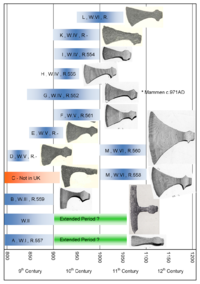Difference between revisions of "Axes"
m (→Throwing axes) |
m |
||
| Line 29: | Line 29: | ||
==References== | ==References== | ||
| − | {{Ref| | + | {{Ref|Mould, Carlisle & Cameron 2003}} |
| − | {{Ref| | + | {{Ref|Petersen 1919}} |
| − | {{Ref| | + | {{Ref|Schietzel 2014}} |
| − | {{Ref| | + | {{Ref|Thompson 2004}} |
| + | {{Ref|Westphal 2006}} | ||
| + | {{Ref|Wheeler 1927}} | ||
| + | {{Ref|Wheeler 1935}} | ||
<HarvardReferences /> | <HarvardReferences /> | ||
Revision as of 17:56, 28 September 2015
| Axes |
|---|
|
Hand axes
...with beards
...without beards
Throwing axes
I am currently unaware of any evidence for throwing axes from the Viking Age (Ad 793-1100). A type of axe called a 'Francisca' was specifically designed for throwing. It dates to the period AD 400-550. [WHEELER 1935]:p.141. Wheeler suggests that it evolves into the bearded axe of the Viking Age [WHEELER 1927]:p.24.
It has been suggested that small axes such as the Mammen Axe, from Mammen in Denmark, may have possibly been thrown [CITATION NEEDED].
Broad axe (Dane axe)
Leather axe loops
A strip of waste leather with a slit cut down its center tucked through the belt. The axe is dropped through the two slit holes. Ideally leather should be thin enough to snap if a firm tug is made upon the axe handle.
Art
--
Literature
--
Archaeology
- 11 finds of calf skin strips with a slit at each end have been found at York and dated to the C10th / early C11th (15715-25). [MOULD, CARLISLE & CAMERON 2003]:p.3401
- Similar finds have been found in Hedeby and London. [MOULD, CARLISLE & CAMERON 2003]:p.3401
Discussion
Although the exact use of these strips is impossible to deduce and Cameron suggests uses such as a method of knife sheaf suspension or a way of making a longer daisy chain style of leather strap.
We never see axes suspended from the waist in manuscripts. Even so it is felt that some mechanism for wearing an axe at the waist must of existed as just simply tucking the axe through the belt would have been hindering to movement and not secure.
Edge protectors for axe
Edge protectors of wood have been found in Hedeby, Denmark [WESTPHAL 2006] [SCHIETZEL 2014]:p.579
References
